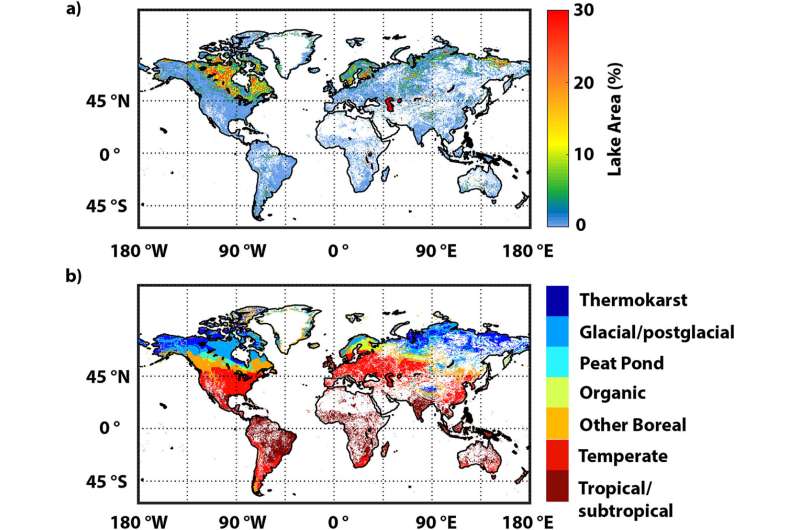(a) Lake area density (% of grid cell area) and (b) ecoclimatic lake type classification. White space indicates grids with no lakes present. Credit: Journal of Geophysical Research: Biogeosciences (2022). DOI: 10.1029/2022JG006793
Methane is well known as a potent greenhouse gas that is emitted into the atmosphere by human activity and contributes significantly to global warming.
Methane can also be released by natural processes, including those in lakes, wetlands, and rivers. In lakes, the gas may diffuse from the water or bubble up from lake bed sediments. Previous research has produced widely varying estimates of the total amount of methane released by lakes worldwide.
Now, Johnson et al. provide an updated estimate of lakes' methane emissions. They compiled and analyzed new and updated data on a variety of factors, including lake area, temperature-related seasonal variations in methane release, satellite-derived information on how long lakes remain iced over each year, and variations in methane release between lakes in different regions with different climates and ecology.
The researchers found that lakes release a total of about 42 million tons of methane into the atmosphere per year. This new estimate is lower than previous estimates.
The new research involved the creation of high-resolution data sets that could aid a wide range of investigations into Earth's methane cycle, computational climate models, and more. According to the authors, future research could also address the difficulty of distinguishing lakes from other aquatic features (such as wetlands and reservoirs), the challenges in directly measuring methane fluxes from lakes, and a shortage of detailed studies of tropical lakes.
More information: Matthew S. Johnson et al, Methane Emission From Global Lakes: New Spatiotemporal Data and Observation‐Driven Modeling of Methane Dynamics Indicates Lower Emissions, Journal of Geophysical Research: Biogeosciences (2022). DOI: 10.1029/2022JG006793
Provided by American Geophysical Union
This story is republished courtesy of Eos, hosted by the American Geophysical Union. Read the original storyhere.
























